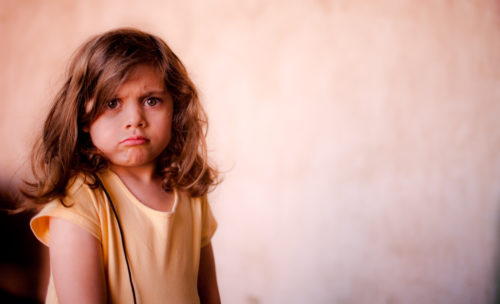 Self-hurting in children is often seen as a coping mechanism when difficult feelings arise. Some of these difficult feelings that your child may be unable to express can include but are not limited to: guilt, sadness, anxiety, frustration, low self-worth, and self-blame. When a child goes through a life-changing transition like adoption, they may not know any appropriate strategies to express themselves. Without knowing how to appropriately cope and express these feelings and emotions, children may find no other choice but to use their own body as a release. When a child is physically hurt, their body responds by producing endorphins, which serve as temporary pain relievers that can give your child a short-term feeling of peace. By inflicting pain on themselves, it distracts their minds from the emotional pain they may bear. Because this route may seem easier to process for children, the temporary relief they feel can become a fixation, which can lead to a pattern of this behavior reoccurring.
Self-hurting in children is often seen as a coping mechanism when difficult feelings arise. Some of these difficult feelings that your child may be unable to express can include but are not limited to: guilt, sadness, anxiety, frustration, low self-worth, and self-blame. When a child goes through a life-changing transition like adoption, they may not know any appropriate strategies to express themselves. Without knowing how to appropriately cope and express these feelings and emotions, children may find no other choice but to use their own body as a release. When a child is physically hurt, their body responds by producing endorphins, which serve as temporary pain relievers that can give your child a short-term feeling of peace. By inflicting pain on themselves, it distracts their minds from the emotional pain they may bear. Because this route may seem easier to process for children, the temporary relief they feel can become a fixation, which can lead to a pattern of this behavior reoccurring.
When you find your child having self-hurting behaviors, it is essential to communicate and reassure them that you are a safe person they can trust and feel comfortable with. As a parent, it will be normal to feel a range of emotions when you find your child exercising these behaviors; shock, denial, anger, guilt, sympathy, sadness, etc. Your feelings are valid. While addressing your child, however, you should try your best to show empathy as your primary emotion. Empathy can help your child see that you are trying to understand their feelings and that their emotions are valid. Although it will be tough, your response should be to remain calm and to attend to their physical needs with compassion, not judgment or panic. If you are able to talk to your child and discuss when these emotions begin (big test at school coming up, a dentist appointment, a friend’s birthday party, an anniversary of an occasion, etc.) you and your child both can start identifying negative feelings and begin to recognize those related triggers that lead them to self-hurting behaviors. You can work together on finding alternative outlets to cope and express emotion in a healthier manner. Some distractions or tools to create substitution behaviors to try are:
- Create a coping kit. Try putting positive and uplifting items into a shoebox or another small container to keep in an accessible spot for your child. Items can include a journal, book they enjoy reading, art supplies, stress ball, stuffed animal, photo of friends and family, “Where’s Waldo?”, crosswords, etc. Include anything your child finds calming or inspiring.
- Listening to music. Avoid triggering music that you know will worsen their mood or make your child anxious. Contrary to what you might think, playing the music loudly can often provide relaxing relief. Loud music also tends to make dancing more enjoyable. Dancing to the music can increase your child’s heart rate and release adrenaline, which may be able to substitute for the endorphins being released when your child is in pain.
- Creative Activities. Finding a musical instrument such as a guitar to pluck at the strings, or a hand drum to be able to slap and hit may be sensuous and distracting. Painting, coloring, and sketching are also creative activities to try. Printing out elaborate (but age-appropriate) coloring pages online can be distracting and stimulating.
- Animal Therapy. Cuddling with a pet such as a dog or cat can be soothing and comforting.
- Physical Activities. Any activity that gets your child’s heart rate up! If running is something your child doesn’t enjoy, try making games out of it such as, “How many times can you run to the swing set and back in one minute?” Other activities such as jump roping, hula-hooping, hopping, bike riding, etc. are all good options to try too.
- Things such as: holding an ice cube, tearing up newspapers or old magazines, shredding a sheet, snapping a rubber band, sucking on a lemon peel, or pounding a pillow are other actions that may be distracting and allow your child to work through their current feelings.
It is also important to be in communication with your child’s school about their self-hurting behaviors. You will want your child’s school to be educated about self-hurting so they can build a positive school community to support your child’s social and developmental growth, while encouraging effective emotional coping skills. Between you and your child’s teacher, try to come up with a plan or routine that will take place if your child begins self-hurting at school. Make sure there is a safe place for your child to go to work through their emotions; this does not have to be out of the room, but can be a designated chair, table, carpet, corner, or anywhere else your child can feel relaxed and safe. It is important to reassure your child that these are not punishment spots and that they are never in trouble when they have these behaviors. In these areas, have an easily-accessible activity for your child to concentrate on. Maybe create a Coping Kit for school and have multiple options for them. It would also be a good idea to have a specific person available to attend to your child, such as the school counselor. Make sure to discuss with the school what steps will be taken if your child’s self-hurting results in bleeding or requires medical assistance.
While I can understand that your child’s safety is your priority, it is important to note that their self-hurting behaviors can take a toll on you as well. “You can’t pour from an empty cup. Take care of yourself first.” Make sure you are also being taken care of. If you find yourself needing immediate assistance or someone to talk to/get advice from, here is a link to ready-now therapists who are available via phone, e-mail, webcam, or online chat: https://www.theravive.com/therapists/e-counseling.aspx .
For more information on child self-hurting, a great resource to access is the Cornell Research Program on Self-Injury and Recovery: http://www.selfinjury.bctr.cornell.edu/
Michaela Recker completed an internship with MLJ Adoptions as part of her Bachelor’s of Social Work studies at University of Iowa.
